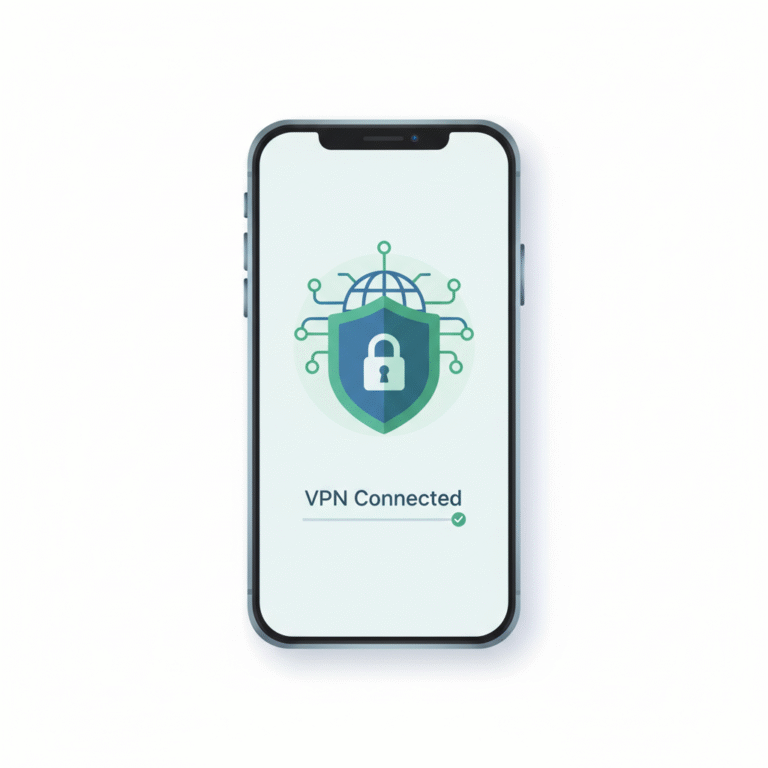What Does VPN Do — Technical Functions, Benefits, and Limits
Understanding what does VPN do is essential for network engineers, IT managers, and cybersecurity practitioners. A Virtual Private Network (VPN) establishes an encrypted tunnel between a device and a remote server, securing data transmission and masking user identity from third parties. This mechanism forms a cornerstone of enterprise security and modern digital privacy strategies.
What does a VPN do — the core functions explained
A VPN encrypts data before it leaves your device, routes it through a remote VPN server, and decrypts it at the destination. This sequence conceals the user’s IP address and makes traffic appear as if it originates from the VPN’s endpoint rather than the user’s network.
For enterprises, VPNs enforce confidentiality across hybrid infrastructures—linking remote users, branch offices, and data centers. On a consumer level, VPNs protect data in transit over untrusted networks such as public Wi-Fi. The encryption standard most providers rely on is AES-256, combined with secure tunneling protocols like OpenVPN, IKEv2/IPsec, or WireGuard.
The principle aligns with core security tenets defined in RFC 4301 (source: RFC 4301), establishing the IPsec framework for internet communication security.
How does a VPN work? The tunnel, encryption, and routing
A VPN operates through three primary components:
- Encryption layer – converts readable data into ciphertext using cryptographic algorithms.
- Tunneling protocol – encapsulates packets to ensure integrity and authentication.
- VPN server routing – replaces the source IP address, adding anonymity and geographical flexibility.
Each VPN protocol balances speed and security differently. WireGuard offers low-latency connections suitable for mobile or real-time workloads, whereas OpenVPN maintains higher compatibility with legacy systems. Network engineers frequently configure split tunneling to route only sensitive traffic through the VPN while maintaining direct routes for high-bandwidth applications.
For organizations, understanding tunnel negotiation (IKE) and encapsulation overhead is crucial in network capacity planning. Administrators often test multiple protocols and cipher suites to validate throughput performance across vendors such as NordVPN or AirVPN vs NordVPN comparative analyses.
Why would you use a VPN? Main benefits by scenario
Enterprise application
Businesses deploy VPNs to secure inter-office traffic, enable secure remote access, and maintain compliance with standards like ISO 27001 or NIST SP 800-53. A properly implemented VPN ensures that confidential resources remain accessible only through authenticated, encrypted channels.
Personal privacy
For individuals, VPNs mitigate the risk of data interception on open Wi-Fi networks and prevent ISPs from tracking browsing behavior. They also enable access to geo-restricted services, which can be vital for global collaboration or research tasks.
Cloud and hybrid networks
Cloud-connected organizations integrate VPN gateways within virtual private clouds to extend internal network policies. Services such as AWS Client VPN and Azure VPN Gateway follow this same encapsulation logic.
The Cloudflare Learning Center provides a detailed visual breakdown of these architectures (source: Cloudflare).
What a VPN won’t do — limitations and misconceptions
A VPN does not make a system inherently secure from all threats. It protects the data in motion, not the endpoints themselves. Malware infections, phishing campaigns, or compromised credentials bypass VPN protection layers entirely.
Another misconception is that VPNs provide full anonymity. In reality, anonymity depends on log policies, jurisdiction, and whether the provider uses third-party audits. While reputable providers enforce no-log policies and RAM-only servers, users should still treat VPNs as one layer within a multi-factor security posture.
For example, pairing encrypted DNS (see Is Encrypted DNS an Alternative to VPN) with a VPN reduces DNS leakage but does not eliminate browser fingerprinting or endpoint telemetry.
Is using a VPN legal? Jurisdiction and compliance factors
The legality of VPNs varies globally. In most Western jurisdictions, VPN usage is fully legal, provided it isn’t used to mask unlawful activity. However, several countries—such as China, Iran, and the UAE—restrict or regulate VPN use for data sovereignty reasons.
IT managers must confirm compliance with local telecom regulations when deploying enterprise VPN endpoints across multiple regions. Logs and encryption standards may fall under export or surveillance laws, requiring vendor documentation and potential licensing.
Articles such as is VPN legal in China – What You Must Know (2025) illustrate the importance of these legal nuances for operational continuity.
Constraints and performance:
VPN performance is influenced by several measurable factors:
- Server proximity – Latency increases as physical distance grows.
- Encryption overhead – Stronger ciphers consume more CPU cycles, particularly on embedded devices.
- Protocol efficiency – WireGuard’s lean design delivers higher throughput than OpenVPN under similar encryption strength.
- ISP throttling and bandwidth caps – Even encrypted, overall speed may degrade if ISPs deprioritize VPN packets.
- Concurrent connections – Enterprise gateways must scale throughput across hundreds of tunnels simultaneously.
Empirical tests under 100 Mbps broadband show a 10-20 % reduction in speed with modern VPN protocols. These constraints highlight why endpoint optimization, server selection, and hardware acceleration (e.g., AES-NI) remain essential.
For context, TechRadar benchmarked top VPNs in 2025, showing only single-digit percentage differences among premium vendors (source: TechRadar).
How a VPN affects performance: speed, protocol choice & best practices
VPNs influence latency, throughput, and jitter, which are critical for applications requiring stable real-time data flow such as VoIP or secure video conferencing. Network engineers evaluate performance based on four variables:
- Latency overhead — Every encryption/decryption cycle adds milliseconds to round-trip time.
- Protocol type — OpenVPN UDP generally provides lower latency than TCP, while WireGuard uses modern cryptography (ChaCha20) to reduce CPU load.
- Server load — Shared servers cause congestion and slower data transfer; premium VPN providers use load balancing to mitigate this.
- Routing complexity — The number of hops between your location and the VPN exit node directly affects response time.
Enterprise teams mitigate degradation by deploying regional VPN hubs closer to users and implementing split tunneling, where only sensitive data traverses the encrypted path. This strategy maintains performance for non-sensitive traffic.
For further insight, Cloudflare’s Network Layer Security Guide (source: Cloudflare) demonstrates how latency and packet overhead evolve under different protocols.
How to set up a VPN on different devices: phone, router, and smart TV
VPN deployment methods differ depending on hardware and OS environment.
On desktops and mobile devices
Most VPN clients offer native applications for Windows, macOS, Android, and iOS. These use system-level network extension frameworks. For instance, IKEv2/IPsec is native to macOS and iOS, ensuring stable reconnection when switching between Wi-Fi and cellular.
On routers
Installing a VPN at the router level extends protection to all connected devices without individual client apps. Open-source firmware like DD-WRT or OpenWRT supports OpenVPN and WireGuard modules for site-to-site tunnels. This configuration suits small offices where centralized policy enforcement is required.
On smart TVs and IoT
Smart TVs typically lack built-in VPN capability. IT administrators may route traffic through a configured router VPN or use Smart DNS fallback to retain content availability. It’s a best practice to isolate IoT devices from corporate VPNs to avoid lateral movement risk.
To understand router-level configuration better, see what is a VPN concentrator, which describes multi-tunnel VPN hardware for enterprise-scale access control.
How secure is a VPN? Evaluating cryptographic and operational integrity
Security strength depends not only on cryptographic algorithms but also on key exchange mechanisms, certificate management, and provider transparency.
Encryption and key management:
- Modern VPNs use Perfect Forward Secrecy (PFS) to generate ephemeral session keys, preventing retrospective decryption.
- Elliptic Curve Diffie-Hellman (ECDH) exchange in WireGuard improves both efficiency and security.
Operational trust:
- Vendors should undergo independent audits verifying “no log” claims.
- RAM-only servers ensure that session data is wiped upon reboot, reducing risk of forensic recovery.
Endpoint vulnerabilities:
VPNs cannot prevent exploitation of compromised devices. For example, a machine infected with keyloggers or credential-stealing malware remains vulnerable even through an encrypted tunnel. Therefore, endpoint protection suites and network segmentation are vital adjuncts.
For deep cryptographic reference, consult Wikipedia’s VPN encryption overview (source: Wikipedia).
Business vs. personal use — distinct operational requirements
Business perspective
Enterprises use VPNs primarily for secure remote connectivity and compliance. Policy-based VPNs integrate with RADIUS or LDAP authentication to enforce role-based access control. Site-to-site configurations allow secure communication between data centers, ensuring end-to-end confidentiality.
Central logging, multi-factor authentication, and integration with Zero Trust Network Access (ZTNA) frameworks are increasingly common. This approach aligns with evolving cybersecurity frameworks that blend identity verification with encryption layers.
Personal perspective
Individual users focus on privacy and content access. Providers like NordVPN or ExpressVPN, tested in our ExpressVPN Review – Tested in 2025, offer optimized servers for streaming, gaming, and P2P.
These configurations use smart routing algorithms that dynamically select the lowest-latency server, minimizing packet loss and maintaining bandwidth consistency.
Emerging protocols and technologies shaping the VPN landscape
- WireGuard — Lightweight, open-source, and integrated directly into the Linux kernel; uses streamlined cryptographic primitives like ChaCha20 and Poly1305.
- Post-quantum cryptography (PQC) — VPN vendors are experimenting with hybrid schemes combining ECDH with quantum-resistant key exchanges.
- VPN over HTTPS (DoH and DoT) — Layering VPN tunnels through encrypted DNS requests to reduce detection and blocking in restrictive regions.
- SASE and ZTNA frameworks — Gartner-defined architectures merging networking and security. These frameworks may eventually supersede traditional VPNs by applying per-session access policies.
Professionals designing enterprise security roadmaps should follow updates from IETF working groups and research bodies publishing VPN-related drafts on rfc-editor.org (source: RFC Editor).
Region-specific compliance and operational risk
Data protection regulations such as GDPR, CCPA, and national cybersecurity laws impose location-based obligations. Using VPN exit nodes outside compliance jurisdictions may trigger violations if data crosses unapproved boundaries.
For example, healthcare organizations in the EU using external VPN providers must ensure their servers reside within EEA boundaries to meet data residency requirements. Similarly, financial institutions under PCI DSS must log VPN access events for audit traceability.
Network engineers should coordinate with legal teams to document VPN usage policies and user consent mechanisms. Failure to maintain audit-ready logs can result in regulatory penalties.
What does a VPN do for specific sectors — practical examples
Remote workforce
For distributed enterprises, VPNs form the foundation of secure remote access. Employees connecting through corporate VPNs authenticate using certificates or SSO tokens, ensuring compliance with identity and access management frameworks. Network segmentation prevents unauthorized lateral movement.
Data center and cloud interconnects
VPNs connect hybrid infrastructures by linking on-premises networks to cloud virtual networks via IPSec tunnels. This ensures encrypted, private connectivity for workloads in AWS, Azure, or GCP. Using dynamic routing protocols like BGP over VPN allows scalability and high availability.
Security operations
Security teams use VPNs for controlled threat-intelligence gathering and penetration testing. By masking source IPs, analysts can examine malicious infrastructure without attribution risk. However, all such operations must comply with legal mandates and internal authorization workflows.
For more about secure tunneling across enterprise environments, see a point to point vpn is also known as a site-to-site VPN.
What a VPN doesn’t replace — boundaries of responsibility
A VPN provides transport-layer confidentiality but does not enforce content filtering, intrusion detection, or endpoint hardening. Security architects must avoid overreliance on it.
- No malware mitigation: VPNs encrypt traffic; they don’t inspect payloads. Intrusion detection or NGFW systems are required for deep packet inspection.
- No credential security: Compromised user accounts remain a risk even within encrypted channels. Implement MFA and conditional access.
- No full anonymity: VPN providers can see connection metadata. Anonymous networks like Tor or corporate relay systems handle that differently.
The Kaspersky Cybersecurity Blog emphasizes that VPNs complement, not substitute, endpoint defenses (source: Kaspersky). Understanding this distinction is crucial for layered security planning.
Constraints and performance: revisited for real-world operations
In field conditions, real throughput rarely matches lab performance metrics. Testing under concurrent user loads and varied ISPs exposes several persistent factors:
- Hardware acceleration: AES-NI and dedicated VPN ASICs on enterprise routers can improve encryption efficiency by 40–60 %.
- Mobile context: On 5G networks, high handoff frequency can trigger tunnel renegotiations, momentarily interrupting sessions.
- QoS configuration: Without proper Quality of Service tagging, VPN packets may compete with bulk traffic, reducing priority.
Network administrators must benchmark VPN tunnels using reproducible metrics—latency (ms), jitter (ms), packet loss (%), and throughput (Mbps)—under consistent conditions.
Referencing controlled tests from TechRadar’s 2025 VPN performance report (source: TechRadar), properly optimized VPN infrastructures maintain >90 % of baseline throughput with minimal packet loss.
Advanced VPN implementations and automation
Policy-based automation
Modern enterprises integrate VPN management into infrastructure-as-code pipelines using tools like Terraform and Ansible. This enables reproducible deployments, auditability, and rollback.
Zero Trust overlay
Zero Trust VPN extensions authenticate each session dynamically rather than relying solely on network perimeter. By combining device posture checks with adaptive MFA, the system reduces the attack surface.
Observability and telemetry
Centralized logging systems collect VPN session metadata—connect times, tunnel states, failed handshakes—for SIEM correlation. These insights enhance incident detection and SLA monitoring.
Integration with observability stacks ensures compliance and improves mean time to repair (MTTR) during outages.
Best practices for sustained VPN reliability
- Use reputable providers with transparent privacy policies and third-party audits.
- Rotate cryptographic keys periodically to prevent long-term compromise.
- Enable kill switches to block traffic leaks when the tunnel drops.
- Apply MFA for all user authentications.
- Monitor latency trends and conduct monthly stress tests.
- Segment VPN gateways between user groups to contain breach exposure.
For teams focused on performance benchmarking, reviews like Private Internet Access (PIA) review 2025 – Is It Worth It? analyze throughput stability under diverse geographies and configurations.
Future of VPNs in enterprise security architecture
VPNs will remain relevant but evolve toward SASE and ZTNA paradigms that integrate identity-aware access with real-time risk scoring. While traditional VPNs offer encrypted transport, future models focus on continuous verification of user and device trust.
Emerging solutions will use machine learning to detect anomalous session behavior, integrating with SIEM and EDR platforms. For network engineers, understanding both classical tunneling and these adaptive frameworks ensures readiness for post-VPN architectures.
As organizations adopt cloud-native applications, the demand for flexible, policy-driven tunnels will persist—merging VPN principles with software-defined networking.
Conclusion
Ultimately, what does VPN do is more than encrypting traffic—it provides a foundational layer of privacy, trust, and control in a distributed digital ecosystem. From individual data protection to enterprise-grade interconnectivity, VPNs remain essential for securing communications amid evolving cyber threats. Maintaining awareness of legal contexts, performance variables, and integration best practices will ensure VPNs continue to serve as a robust, adaptable security instrument.



